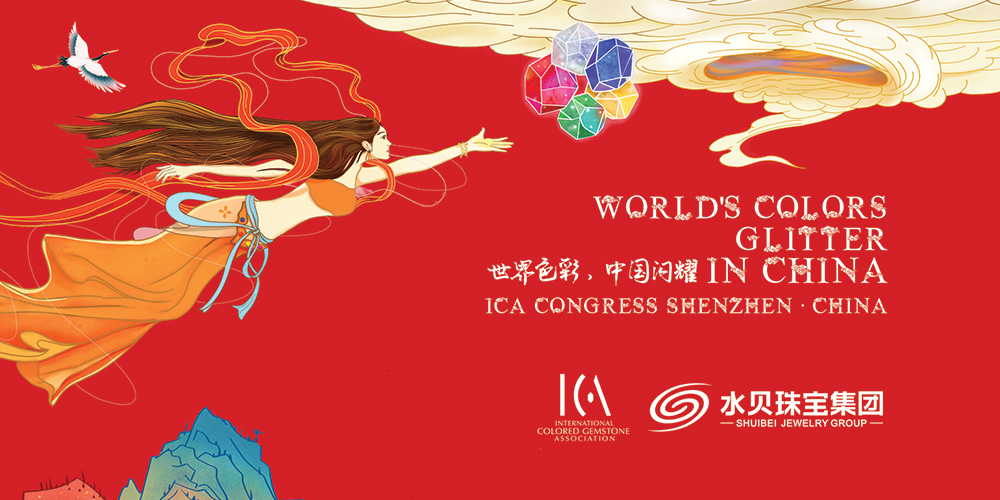- Empty cart.
- Continue Shopping
New Colours of the “Niu” Year – an Exclusive Interview with Clement Sabbagh
February 12, 2021 marks the beginning of the Year of the Ox (“Niu”), the second Chinese zodiac representing hard work, honesty, patience, positivity and perseverance. The coloured gemstone industry is trying to seek a new way out while the Covid-19 continues to cast shadow.
Founded in 1984, The International Colored Gemstone Association (ICA) is a non-profit organization and the only worldwide body created to benefit the global coloured gemstone industry. ICA is comprised of over 700 gem industry leaders from mine to market, including miners, gem cutters, suppliers, retailers, trade associations, gemological laboratories, academia, museums, and more, from 47 countries. The president of ICA, Mr. Clement Sabbagh is a second-generation gemstone miner, cutter and wholesaler. As an industrial leader and a business owner, he spoke candidly from his own observation on the new normal and new trends in 2021.
1)What will be the new normal and new trend in the B2B coloured gemstones trading in 2021?
Clement Sabbagh: As with many other industries, the coloured gemstone business has been adversely affected by the pandemic, especially since sales in our industry have always relied heavily on one-on-one interaction at on-site fairs or client visits.
Our industry is still adapting to what seems to be a “new normal” which we expect to prevail and grow in the coming months. This “new normal” won’t replace the personal interactions but rather they will play an important role in parallel to the one-on-one meetings. The experiences so far indicate that e-commerce sales are generally of lower value and there are some limitations with logistics depending on the location of the buyer and seller. The international express mail services have been badly hampered as a result of more lucrative freight taking precious space on the limited flight schedules. Fortunately, there are also many digital initiatives aimed at providing a solution for suppliers and buyers. Some of these hybrid platforms have partnered with secure carriers to facilitate logistics of products and even host product demonstration on site for potential clients.
Additionally, we see a trend of on-site events going “hybrid” by offering a combination of on-site experiences with virtual experiences. This might be a solution for engaging more suppliers and buyers worldwide.
2) In the B2B diamond trading, especially in certified white diamonds, there was an accelerated trend of going digital and online in 2020. However, the B2B trading of coloured stones relies on one-on-one interactions with eye-selection of gems for the very subtle differences in colours. In which aspects will online tools benefit the coloured gemstone industry?
Sabbagh: Trading online is often easier for harmonized products such as diamonds. Unfortunately, it is not so effective for coloured gemstone since each stone has many unique characteristics.
There are digital initiatives underway aimed at suppliers and buyers of coloured gemstones. We expect to soon have a number of these digital solutions available in our industry. With the right tools we have no doubt that we’ll see an increased presence of coloured gemstones online.
We also consider online tools to be a valuable complement to the one-on-one interactions. It’s an environment of great networking potential, for brand storytelling and education. I myself have been able to take part in many Symposiums worldwide despite the travel restrictions currently in place.

Poster of 2021 ICA Congress in Shenzhen China with the theme of “World’s Colours Glitter in China”. Photo courtesy of Shuibei Jewelry Group.
3) What are the new initiatives ICA take to support the coloured gemstones industry in 2021, especially in response to the rising concerns of consumers regarding transparency, sustainability and fair practices?
Sabbagh: We strongly believe in supply chain transparency, sustainability and fair practices as means to offer reassurances to the coloured gemstone consumers. We don’t see it as a trend but a reality.

Left: Clement Sabbagh, ICA President. Photo courtesy of ICA. Right: The Jewelry Trade Center (JTC) in Bangkok is Thailand’s leading trade premises for diamonds, gems and assorted jewellery. It comprises over 180,000 square meters of retail, office and residential space, hosting more than 300 leading retailers and 1,500 wholesalers. Photo courtesy of Julius Zheng.
ICA is encouraging members to advance to a higher level of recognition as ICA Accredited Ethical Members. This accreditation is provided to members who understand and pledge to adhere to a series of ethical standards and to implement a program of continuous improvement within their organizations. ICA Accredited Ethical Members may find that new opportunities open up to them especially when the economy restarts.
During this challenging time, ICA continues to be active online with its newsletters, InColor Magazine, supporting education, and third-party seminars all aimed at maintaining a steady presence, keeping the interest in coloured gemstones and gemstone set jewellery alive and well. ICA has also compiled a valuable resource page on its website highlighting helpful practices and procedures to help navigate their way through the current downturn.
4) What kind of coloured gemstones will be popular in 2021? Apart from its beauty and durability, how does the production volume affect the marketability of a certain coloured gemstone?
Sabbagh: In any given time, different markets favour different gemstones and colours. Apart from what we call “the big three”, Emeralds, Rubies and Sapphires, the popularity of a gem will depend upon several different factors. Celebrity choices can launch a specific gem into the spotlight. Other times, it might be fashion colours, specifically chosen for the season, or complimentary colours to the featured trend. Last year, for instance we experienced a rise in interest in gemstones in blue hues such as Sapphires, Spinels, Blue Topaz and Aquamarines since Pantone had named “Classic Blue”, the colour for 2020.
This year, Pantone nominated 2 leading colours for 2021: “Illuminating” which will certainly favour gemstones in yellow hues such as Yellow Sapphires, Imperial Topaz, Yellow Opals, Citrines, Diamonds, Golden Beryl (Heliodor), Garnet, Tourmaline, Jade, Peridot (in yellow or lemon), Amber, South Sea Pearls and Zircon, and “Ultimate Grey” which may favour gemstones in shades of grey such as Spinel, Sapphires, Smokey Quartz, Onyx, Gray Jade, Labradorite, Moonstone and even black and gray diamonds.
The mass market will often turn away from rare gems in low supply and favour stones that have a reliable production from the source. On the other hand extremely rare and fine gems are in great demand at the auctions and by discerning buyers. For example, Padparadsha sapphires are very strong in demand but scarce, as are Paraiba tourmalines, even those from the newer sources of Mozambique and Nigeria. This situation is not likely to improve, and they are not used widely in brand collections. Designers are looking for more available gem materials to create the classic line of gem-set suites.
5) In September 2021 [*2022], the ICA Congress will be held in Shenzhen, China. What message will it convey? How important is the Chinese coloured gemstone consumer market?
Sabbagh: ICA sees a huge potential for coloured gemstones in China and this Congress certainly is a valuable tool to further develop partnerships and collaborative initiatives between our industry and the large jewellery industry in the country. China has a population of 1.4 billion, but only 100 million jewellery buying consumers. To participate in this huge market provides the industry with new and exciting opportunities in a fast growing economy looking for gem product to fuel its jewellery manufacturing industry.
The theme for the 2021 [*2022] ICA Congress in Shenzhen China is: “World’s Colors Glitter in China”. It represents not only the coloured gemstones of various countries in the world, but also portrays a multi-coloured treasure culture around the globe, showcasing the preferences of individual consumers as well as a colourful lifestyle.
Shenzhen offers not only a great venue for the 2021 [*2022] ICA Congress, but it also places all of us in the most representative city in the world’s most important jewellery industry. The “Guangdong-Hong Kong-Macao Greater Bay Area” with Shenzhen at its heart, represents a premier city of culture and innovation. The ICA Congress is expected to congregate a large number of the world’s leading industry professionals to convey the vitality and synergy of the industry and the passion for coloured gemstone to China.
6) How will the manufacturing and trading of China and Thailand contribute to the coloured gemstone industry in 2021? How do the two countries interact with each other?
Sabbagh: China remains the fastest growing economy in the world. The country has reacted and rebounded very fast to the pandemic gloom and Chinese consumers keep buying coloured gems jewellery with much more educated consumer base every day the middle class and upper middle class has increased.
China jewellery sector is therefore in demand for raw material, meaning all gems and the travel restrictions have kept the Chinese market under-supplied for its needs.
China is always interested to get closer to the source and to acquire rough or buying mines whenever they can to ensure a constant supply for their fast growing market. Still the second largest economy in the world, as far as coloured stones are concerned, China is the drag force of the coloured stone sector with Emerald, Ruby and Sapphire faring in first position only unchallenged by Jade. China is expanding internationally on all coloured gems and has become the most serious buyers at the moment.
As for Thailand, the high end jewellery manufacturing sector is affected but will survive. Thailand with its 0% tax on gems has become a very strong platform where African Rough is sent constantly. Chanthaburi is the world capital for ruby trade and a sapphire big hub where Thai gem firms have come to master treatments better than China will ever do.

One of the gem markets in Chanthaburi, the city of gems in Thailand. Photo courtesy of Julius Zheng.
Bangkok has seen a flow of Chinese gem dealers setting shop in the Jewelry Trade Center (JTC) in Bangkok or in its neighbourhood, and either selling online to china or shipping from Bangkok to China, stones coming from all producing countries.
Bangkok is becoming a platform similar to Hong Kong where fine gems can find their way to Chinese and other customers. With the downfall of Hong Kong and the reduction of business and people traffic in the territory, Bangkok is gradually taking the lead as the easiest and friendly place to do international gem business.
Thailand is also one of the first places for the manufacturing and design of exceptional mid-high and high-end jewellery, and consumes loads of coloured gems for all markets. Practically all international gem testing labs have their headquarters or branches in Bangkok to provide service aiming at gem buyers, especially Chinese.
About the author: Julius Zheng is a jewellery industry analyst and senior consultant to various important firms and institutes. He has developed various projects that connect China’s dia¬mond, coloured gemstones and jewellery sectors with international markets, including organizing around 30 China Buyer Delegations, and has developed international gemological educa¬tional programs. Formerly Gen¬eral Manager of Rapaport China, he has over 20 years’ international working experience in the industry. He is also a member of Executive Board of Bangkok Diamonds and Precious Stones Exchange (WFDB affiliated).
Julius Zheng



